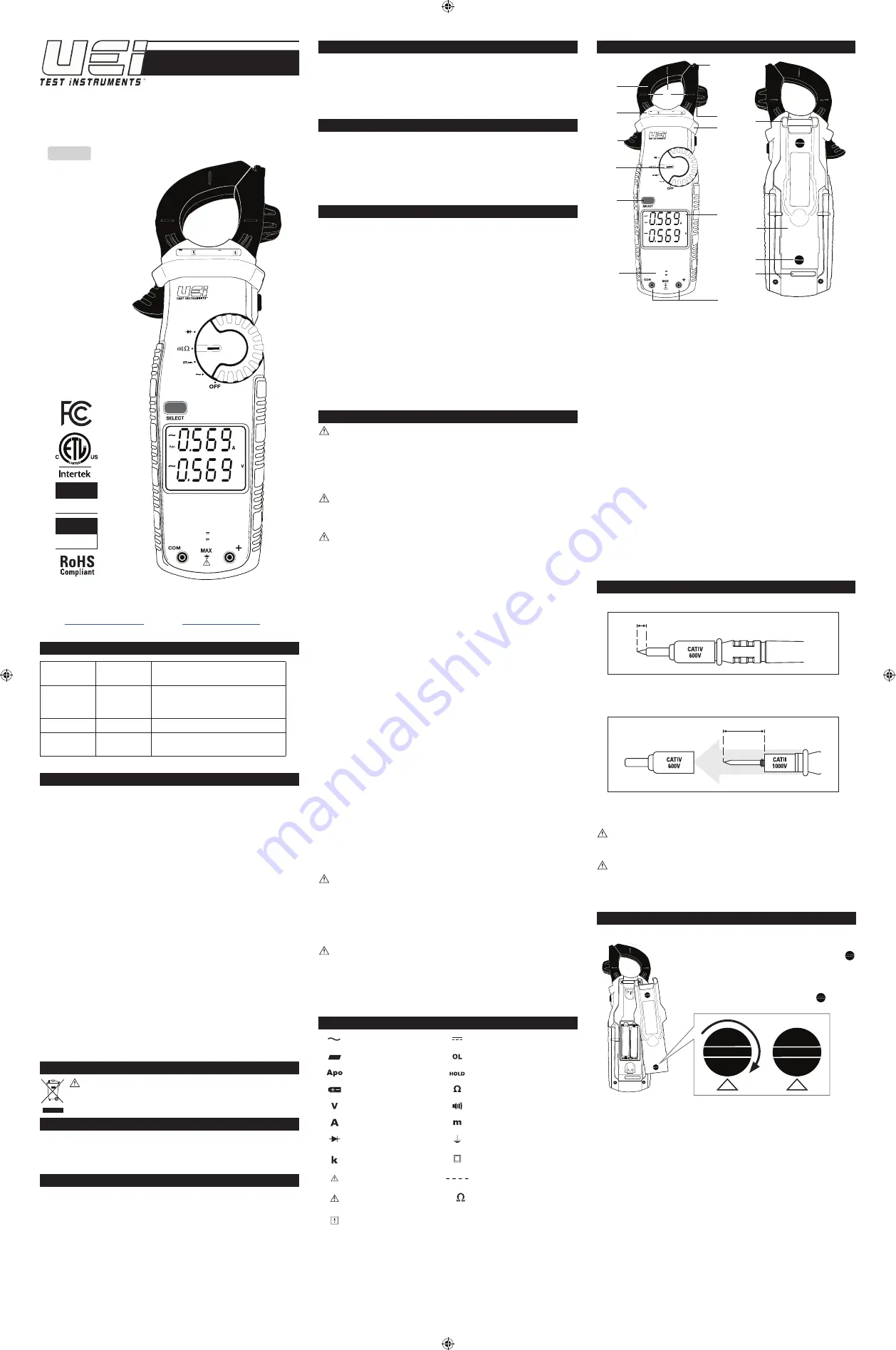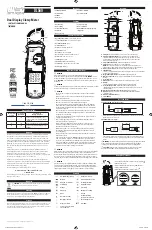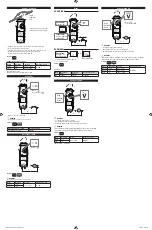
CAT III
600V 400A
DL569
V
CATIII 600V
2000µA
CATIV 300V
V
mV
AUTO
INSTRUCTION MANUAL
ENGLISH
DL569
Dual Display Clamp Meter
1-800-547-5740
www.ueitest.com
• email:
info@ueitest.com
300V
CAT IV
600V
CAT III
Measurement
Category
Short-Circuit
(typical) kA
a
Location in the
building installation
II
< 10
Circuits connected to mains socket
outlets and similar points in the MAINS
installation
III
< 50
Mains distributions parts of the building
IV
> 50
Source of the mains installation in the
building
Category Definitions
Warranty
The DL569 is warranted to be free from defects in materials and workmanship
for a period of 1 year from the date of purchase. If within the warranty period
your instrument should become inoperative from such defects, the unit will be
repaired or replaced at UEi’s option. This warranty covers normal use and does not
cover damage which occurs in shipment or failure which results from alteration,
tampering, accident, misuse, abuse, neglect or improper maintenance. Batteries
and consequential damage resulting from failed batteries are not covered by
warranty.
Any implied warranties, including but not limited to implied warranties of
merchantability and fitness for a particular purpose, are limited to the express
warranty. UEi shall not be liable for loss of use of the instrument or other
incidental or consequential damages, expenses, or economic loss, or for any claim
or claims for such damage, expenses or economic loss.
Warranty only covers hardware and does not extend to software applications.
A purchase receipt or other proof of original purchase date will be required before
warranty repairs will be rendered. Instruments out of warranty will be repaired
(when repairable) for a service charge.
For more information on warranty and service, contact:
www.ueitest.com • Email: info@ueitest.com
1-800-547-5740
This warranty gives you specific legal rights. You may also have other rights, which
vary from state to state.
Disposal
CAUTION:
This symbol indicates that equipment and its accessories shall
be subject to separate collection and correct disposal.
Cleaning
Periodically clean your meter’s case using a damp cloth. DO NOT use abrasive, flammable
liquids, cleaning solvents, or strong detergents as they may damage the finish, impair
safety, or affect the reliability of the structural components.
Storage
Remove the batteries when instrument is not in use for a prolonged period of time. Do not
expose to high temperatures or humidity. After a period of storage in extreme conditions
exceeding the limits mentioned in the General Specifications section, allow the instrument
to return to normal operating conditions before using it.
Copyright © 2021 Kane USA Inc. All Rights Reserved. 202151 1121
Functions
Features
• 750V AC/1000V DC
• millivolts DC
• 400A AC
• Diode test
• Audible continuity
• Resistance: 40kΩ
• Dual display
• Auto ranging
• Low battery indicator
• Data Hold
• Auto power off
• Test lead storage
• Auto calibration
• Built-In Magnet w/ hanging strap: .
(Optional)
General Specifications
•
Operating Temperature:
32˚ to 122˚F (0˚ to 50˚C)
•
Storage Temperature:
-4˚ to 140˚F (-20˚ to 60˚C)
•
Operating Humidity:
<80%
•
Pollution Degree:
2
•
Display:
3 3/4 digits, 4,000 count
•
Refresh Rate:
3/sec
•
Over-range:
“OL” is displayed
•
Apo:
Auto power off after 30 minutes of use.
•
Dimensions:
8.70” x 2.52” x 1.41”
•
Item Weight:
0.62 lbs
•
CAT Rating:
CATIV 300V, CATIII 600V
•
Certifications:
cETLus UL 61010-1: 2012, IP42
•
Battery Type:
(AAA) 2
Important Safety Warnings
WARNING
Read entire Safety Notes section regarding potential hazards and proper
instructions before using this meter. In this manual the word “
WARNING
” is used
to indicate conditions or actions that may pose physical hazards to the user. The
word “
CAUTION
” is used to indicate conditions or actions that may damage this
instrument.
WARNING
To ensure safe operation and service of the tester, follow these instructions. Failure
to observe these warnings can result in severe injury or death.
WARNING
• Before each use, verify meter operation by measuring a known voltage or
current.
• Never use the meter on a circuit with voltages that exceed the category
based rating of this meter.
• Do not use this meter during electrical storms or in wet weather.
• Do not use the meter or test leads if they appear damaged.
• Ensure meter leads are fully seated and keep fingers away from the metal
probe contact when making measurements. Always grip the leads behind
the finger guards molded into the probe. For information on test lead shields
instructions on page 19.
• Do not open the meter to replace batteries while the probes are connected.
• Use caution when working with voltages above 60 DC or 25 AC RMS. Such
voltages pose shock hazards.
• To avoid false readings that can lead to electrical shock, replace batteries if
a low battery indicator appears.
• Unless measuring voltage or current, shut off and lockout power before
measuring resistance or capacitance.
• Always adhere to national and local safety codes. Use proper personal
protective equipment (PPE) to prevent shock and arc blast injury where
hazardous live conductors are exposed.
• Always turn off power to a circuit or assembly under test before cutting,
unsoldering or breaking the current path. Even small amounts of current
can be dangerous.
• Always disconnect the live test lead before disconnecting the common test
lead from the circuit.
• In the event of electrical shock, ALWAYS bring the victim to the emergency
room for evaluation, regardless of victim’s apparent recovery. Electrical
shock can cause unstable heart rhythms that may need medical attention.
• If any of the following occur during testing, turn off the power source to the
circuit being tested: arcing, flame, smoke, extreme heat, smell of burning
materials or discoloration or melting of components.
WARNING
Higher voltages and currents require greater awareness of physical safety hazards.
Before connecting the test leads; turn off power to the circuit under test, set
meter to the desired function and range; connect the test leads to the meter first,
then connect to the circuit under test. Reapply power. If an erroneous reading is
observed, disconnect power immediately and recheck all settings and connections.
WARNING
This meter is designed to provide HVAC/R technicians with the capabilities they
need to diagnose and repair HVAC/R system. Observe all recommended safety
procedures that include proper lockout utilization and use of personal protective
equipment that includes safety glasses, gloves and flame resistant clothing.
Symbols
AC (Alternating current)
DC (Direct current)
Negative
Overload: Range Exceeded
Auto power off Active
Hold/Capture Value
Low Battery
Ohms/Resistance
Voltage
Continuity
Amperage
Milli (x10
-3
or 0.001)
Diode
Ground
Kilo (x10
3
or 1,000)
Double Insulation
(Protection to Class II)
Warning or Caution
No reading detected
Dangerous Levels
k
Kilo Ohms
Safe for disconnect from
live conductors
A. Clamp:
Measure inductive AC current. Opens to 1.25” (32.0mm).
B. Conductor Alignment Marks:
Use to aid the visual alignment of a
conductor when measuring inductive amperage. Greatest accuracy
is achieved when the conductor inside the clamp is centered at the
intersection of these marks.
C. Category Max Indicator:
Maximum CAT Rating for clamp jaw.
D. Clamp Lever:
Opens and closes current clamp jaw.
NOTE:
The clamp uses a high-tension spring to close the jaw. Do not
allow fingers or objects to become pinched in the base as the jaws close.
E. Rotary Selector Dial:
Set Rotary Selector Dial desired function
F. SELECT Button
:
• Press select DCmV or DCV on Voltage setting; to activate Ohms, Continuity
on Ohms/Continuity setting
G. Category Max Indicator:
Maximum CAT Rating for input jacks.
H. Wire Separation Tab:
Use to isolate an individual wire from a bundle for
testing.
I. Test Lead Holder
J. Hand Guide:
Used as a point of reference for the operator’s safety.
K. Display:
• Amps (AC/DC) reading will always display on upper display.
L. Test Lead Input Jacks:
Multifunction and Positive input jacks.
• Multifunction input port used for measuring: AC or DC volts, resistance,
continuity, diode.
M. Bracket for optional magnetic holder strap (
sold separately
).
N. Battery Cover:
Easy access for replacing batteries without breaking
calibration seal.
O. Battery Compartment Latches
P. Serial Number
Overview
N
O
P
CAT III
600V 400A
DL569
V
CATIII 600V
2000µA
CATIV 300V
V
mV
AUTO
H
I
L
M
K
A
C
D
G
E
F
B
J
Test Lead Notes
Cat IV and CAT II Measurement Locations
• Ensure the test lead shield is pressed firmly in place. Failure to use the CAT IV
shield increases arc-flash risk.
CAT II Measurement Locations
• CAT IV shields may be removed for CAT II locations. This will allow testing on
recessed conductors such as standard wall outlets. Take care not to lose the
shields.
WARNING:
Test Lead category protections apply only to test leads and should
not be confused with the meter’s specific CAT rating. Observe the maximum
category protection indicated on the meter the test leads are plugged into.
CAUTION
: If the test leads need to be replaced, you must use a new one
which should meet EN 61010-031 standard, rated CATIII 1000V or better.
4mm
18mm
4mm
18mm
• Rotate Battery Compartment Latches to open position
LOCK
OPEN
• Remove battery cover
• Replace the old batteries with 2 new (AAA) batteries
• Replace the battery cover
• Rotate Battery Compartment Latches to lock
LOCK
OPEN
Battery Replacement
LOCK
OPEN
LOCK
OPEN
DL569_ENG_Manual_202151.indd 1
DL569_ENG_Manual_202151.indd 1
11/29/21 9:27 AM
11/29/21 9:27 AM




















